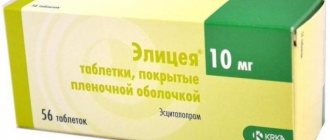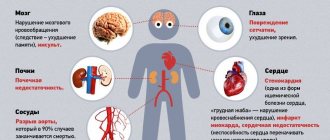SPAZMEX is a modern drug for the treatment of overactive bladder syndrome. Due to its special structure, the drug does not enter the central nervous system and, accordingly, does not lead to such side effects as sleep disorders, attention disorders and a number of others. In addition, SPAZMEX accumulates in high concentrations in the bladder, which makes it highly effective. The drug is practically not metabolized in the liver, so its combination with other medications is permissible, especially in cases of pathology of this organ.
Indications for use of SPAZMEX
The drug should be used for such pathological conditions as:
• Urinary incontinence and urgent (imperative) urge to urinate;
• Neurogenic hyperactivity of the detrusor (the muscle of the bladder, causing its contraction and expulsion of urine) against the background of multiple sclerosis, congenital and acquired diseases of the spinal cord, stroke, spinal injuries and parkinsonism;
• Intermittent catheterization;
• Cystitis with imperative symptoms (frequent urge);
• Daytime and nocturnal enuresis;
• Frequent urination (pollakiuria), frequent urge at night (nocturia);
• Urinary incontinence.
Spazmex, 15 mg, film-coated tablets, 30 pcs.
hypersensitivity to the components of the drug;
narrow-angle and closed-angle glaucoma;
tachyarrhythmia, myasthenia gravis;
urinary retention;
slower evacuation of food from the stomach and conditions predisposing to its development;
renal failure requiring dialysis (Cl creatinine <10 ml/min/1.73 m2);
galactose intolerance, lactase deficiency, glucose-galactose malabsorption;
children's age (up to 14 years).
Carefully:
cardiovascular diseases in which an increase in heart rate may be undesirable - atrial fibrillation, tachycardia, chronic heart failure, coronary heart disease, mitral stenosis, arterial hypertension, acute bleeding; thyrotoxicosis (possibly increased tachycardia); increased body temperature (may further increase due to suppression of the activity of the sweat glands); reflux esophagitis, hiatal hernia, combined with reflux esophagitis (decreased motility of the esophagus and stomach and relaxation of the lower esophageal sphincter can slow down gastric emptying and increase gastroesophageal reflux through the sphincter with impaired function); gastrointestinal diseases accompanied by obstruction - achalasia and pyloric stenosis (possibly decreased motility and tone, leading to obstruction and retention of gastric contents); intestinal atony in elderly or debilitated patients (possible development of obstruction), paralytic intestinal obstruction (possible development of obstruction); diseases with increased intraocular pressure - open-angle glaucoma (mydriatic effect may cause a slight increase in intraocular pressure; therapy adjustment may be required), age over 40 years (risk of undiagnosed glaucoma); ulcerative colitis (high doses can inhibit intestinal motility, increasing the likelihood of paralytic ileus; in addition, the manifestation or exacerbation of such a severe complication as toxic megacolon is possible); dry mouth (long-term use may further increase the severity of xerostomia); renal failure (risk of side effects due to decreased excretion); chronic lung diseases, especially in children and weakened patients (a decrease in bronchial secretion can lead to thickening of secretions and the formation of plugs in the bronchi); myasthenia gravis (the condition may worsen due to inhibition of the action of acetylcholine); autonomic (autonomic) neuropathy (urinary retention and paralysis of accommodation may increase); prostatic hyperplasia without urinary tract obstruction, urinary retention or predisposition to it, or diseases accompanied by urinary tract obstruction (including bladder neck due to prostatic hypertrophy); gestosis (possibly increased arterial hypertension); brain diseases in children (the effects on the central nervous system may be enhanced); Down's disease (possibly unusual pupil dilation and increased heart rate); central paralysis in children (the reaction to anticholinergic drugs may be most pronounced); liver failure.
Instructions for using SPAZMEX
The drug is prescribed orally at a dosage of 10–15 mg two to three times a day before meals. It should be used strictly according to a doctor's prescription. The duration of therapy depends on the severity of symptoms at the time of initiation of therapy and how long it takes for a clinically significant effect to occur. On average, the duration of treatment is two to three months.
A patient with detrusor dysfunction should take the medicine after catheterization of the bladder.
The drug is not addictive.
Drinking alcohol is not recommended during treatment.
SPAZMEX is intended for sale in pharmacies with a doctor's prescription.
The drug is not intended for use by patients (men and women) for prophylaxis without a doctor's prescription.
Spazmex
Hypersensitivity. Caution. Diseases of the cardiovascular system in which an increase in heart rate may be undesirable: atrial fibrillation, tachycardia, CHF, coronary artery disease, mitral stenosis, arterial hypertension, acute bleeding;
thyrotoxicosis (possibly increased tachycardia);
increased body temperature (may further increase due to suppression of the activity of the sweat glands);
reflux esophagitis, hiatal hernia, combined with reflux esophagitis (decreased motility of the esophagus and stomach and relaxation of the lower esophageal sphincter can slow down gastric emptying and increase gastroesophageal reflux through the sphincter with impaired function);
gastrointestinal diseases accompanied by obstruction: achalasia and pyloric stenosis (possibly decreased motility and tone, leading to obstruction and retention of gastric contents);
intestinal atony in elderly or debilitated patients (possible development of obstruction), paralytic intestinal obstruction (possible development of obstruction);
diseases with increased intraocular pressure: closed-angle (mydriatic effect, leading to an increase in intraocular pressure, can cause an acute attack) and open-angle glaucoma (mydriatic effect can cause a slight increase in intraocular pressure; therapy adjustment may be required), age over 40 years (risk of undiagnosed glaucoma );
nonspecific ulcerative colitis (high doses can inhibit intestinal motility, increasing the likelihood of paralytic ileus; in addition, the manifestation or exacerbation of such a severe complication as toxic megacolon is possible);
dry mouth (long-term use may further increase the severity of xerostomia);
renal failure (risk of side effects due to decreased excretion);
chronic lung diseases, especially in young children and weakened patients (a decrease in bronchial secretion can lead to thickening of secretions and the formation of plugs in the bronchi);
myasthenia gravis (the condition may worsen due to inhibition of the action of acetylcholine);
autonomic (autonomic) neuropathy (urinary retention and paralysis of accommodation may increase), prostatic hypertrophy without urinary tract obstruction, urinary retention or predisposition to it, or diseases accompanied by urinary tract obstruction (including bladder neck due to prostatic hypertrophy) ;
gestosis (possibly increased arterial hypertension);
brain damage in children (CNS effects may be enhanced);
Down's disease (possibly unusual pupil dilation and increased heart rate);
central paralysis in children (the reaction to anticholinergic drugs may be most pronounced), tachycardia (may intensify).
Directions for use and dosage
Spazmex tablets are taken orally, before meals, swallowed whole and washed down with a sufficient amount of water. The dosage and duration of treatment are determined individually for each patient, depending on the severity of the disease and its course.
Recommended doses:
- Spazmex 5 mg – 2-3 tablets three times a day with an interval of 8 hours; if the daily dose is 45 mg, you can take 30 mg in the morning and 15 mg in the evening;
- Spazmex 15 mg – 1 tablet three times a day with an interval of 8 hours;
- Spazmex 30 mg – ½ tablet three times a day or 1 tablet in the morning and ½ tablet in the evening.
In case of renal failure with creatinine clearance of 10-30 ml/min, the daily dose is no more than 15 mg.
The average duration of therapy is 2-3 months. In cases where longer-term treatment is necessary, the doctor decides whether to continue therapy every 3-6 months.
Drug interactions
The drug enhances the positive chronotropic effect of beta-adrenomimetics and the m-anticholinergic effect of tricyclic antidepressants, disopyramide, amantadine, antihistamines and quinidine.
Spazmex weakens the effect of cisapride and metoclopramide.
With the simultaneous use of drugs containing colestipol, cholestyramine and guar, the absorption of trospium chloride may be reduced.
The drug affects the secretory and motor function of the gastrointestinal tract and changes the absorption of drugs used simultaneously with it.
Release form and composition
Spazmex is available in the following forms:
- Tablets: biconvex, round, white or almost white (10 pieces in blisters, 3 or 5 blisters in a cardboard pack);
- Film-coated tablets: biconvex, round, white or almost white, with a score, the core and a white or almost white film shell are visible at the break (15 mg - 10 pieces in blisters, 3 or 5 blisters in a cardboard pack; 30 mg - 10 pieces in blisters, 3 blisters in a cardboard pack).
Composition of 1 tablet:
- Active ingredient: trospium chloride – 5 mg;
- Auxiliary components: sodium carboxymethyl starch, corn starch, stearic acid, colloidal silicon dioxide, lactose monohydrate, povidone.
Composition of 1 film-coated tablet:
- Active ingredient: trospium chloride – 15 mg or 30 mg;
- Auxiliary components: microcrystalline cellulose, corn starch, stearic acid, colloidal silicon dioxide, lactose monohydrate, sodium carboxymethyl starch, povidone;
- Film shell: titanium dioxide, stearic acid, hypromellose, microcrystalline cellulose.
Spasmex®
— Diseases of the cardiovascular system, in which an increase in heart rate may be undesirable: atrial fibrillation, tachycardia, chronic heart failure (CHF), coronary heart disease (CHD), mitral stenosis, arterial hypertension, acute bleeding;
- thyrotoxicosis (possibly increased tachycardia);
- increased body temperature (may further increase due to suppression of the activity of the sweat glands);
- reflux esophagitis, hiatal hernia, combined with reflux esophagitis (decreased motility of the esophagus and stomach and relaxation of the lower esophageal sphincter can slow down gastric emptying and increase gastroesophageal reflux through the sphincter with impaired function);
- diseases of the gastrointestinal tract (GIT), accompanied by obstruction: achalasia and pyloric stenosis (possibly decreased motility and tone, leading to obstruction and retention of gastric contents);
- intestinal atony in elderly or weakened patients (possible development of obstruction), paralytic intestinal obstruction (possible development of obstruction);
- diseases with increased intraocular pressure: open-angle glaucoma (mydriatic effect may cause a slight increase in intraocular pressure; therapy adjustment may be required), age over 40 years (risk of undiagnosed glaucoma);
- ulcerative colitis (high doses can inhibit intestinal motility, increasing the likelihood of paralytic ileus; in addition, the manifestation or exacerbation of such a severe complication as toxic megacolon is possible);
- dry mouth (long-term use may cause further increase in the severity of xerostomia);
- renal failure (risk of side effects due to decreased excretion);
- chronic lung diseases, especially in children and weakened patients (a decrease in bronchial secretion can lead to thickening of secretions and the formation of plugs in the bronchi);
- myasthenia gravis (the condition may worsen due to inhibition of the action of acetylcholine);
- autonomic (autonomic) neuropathy (urinary retention and paralysis of accommodation may increase), prostatic hyperplasia without urinary tract obstruction, urinary retention or predisposition to it, or diseases accompanied by urinary tract obstruction (including bladder neck due to prostatic hypertrophy );
- gestosis (possibly increased arterial hypertension);
- brain diseases in children (the effects on the central nervous system may be enhanced);
- Down's disease (possibly unusual dilation of the pupils and increased heart rate);
- central paralysis in children (the reaction to anticholinergic drugs may be most pronounced);
- liver failure.
Side effects
- Digestive system: often - constipation, dyspepsia, abdominal pain, dry mouth, nausea; uncommon – bloating, diarrhea; rarely - mild or moderate increase in transaminase activity, gastritis;
- Cardiovascular system: infrequently – tachycardia; rarely - fainting, hypertensive crisis, chest pain, tachyarrhythmia;
- Respiratory system: infrequently - shortness of breath;
- Musculoskeletal system: rarely - acute necrosis of skeletal muscles;
- Central nervous system: rarely – hallucinations, confusion;
- Urinary system: infrequently - impaired bladder emptying; rarely - urinary retention;
- Organ of vision: infrequently – disturbance of accommodation;
- Allergic reactions: infrequently - skin rash; rarely - Stevens-Johnson syndrome, anaphylactic reactions.
Is it possible for children, pregnant and lactating women?
These categories of people are also not immune to problems with urination. Judging by the reviews, Spazmex helps children effectively. However, if they have not reached the age of 14 years, taking the drug is strictly prohibited. This is due to the lack of controlled clinical trials proving the safety of the drug for younger children.
A doctor may prescribe Spazmex during pregnancy and lactation, but only if the benefit to the mother outweighs the possible risk to the fetus or baby.
Reviews
"Spazmex" is a drug that has proven itself remarkably among doctors and their patients. It eliminates urinary disorders in a short time, returning people’s quality of life to its previous level.
This medicine has an excellent price-quality ratio, clear instructions, and reasonable cost. However, like any other drug, Spazmex has a number of contraindications. Most cases of side effects are associated with non-compliance with the rules of administration and attempts to self-medicate at home.
special instructions
If the function of the muscular lining of the bladder or the internal urethral sphincter is impaired, taking Spazmex should be accompanied by complete release of the bladder using catheterization.
Before starting treatment, the source of autonomic disorders of the bladder should be determined and organic causes of urinary incontinence, nocturia and pollakiuria should be excluded, such as polydipsia, bladder cancer, heart failure and the possibility of urinary tract infection, as they require etiotropic treatment.
At the beginning of therapy, when interacting with alcohol, when replacing the drug or increasing its dose, vision may deteriorate, which must be taken into account when driving a car and working with potentially dangerous mechanisms.
Analogs
"Spazmex" is a drug that is not problematic to purchase. It is widespread and sold in most pharmacies. If for some reason it was not possible to buy it, the decision to replace it with another drug should be made only by the attending physician.
Today, the following analogues of Spazmex are sold on the pharmaceutical market (price, reviews, instructions are identical):
- "Roliten." It comes in the form of tablets that need to be taken 2 times a day. The visible effect occurs approximately a month after the start of therapy. Side effects are: dryness of the oral mucosa, tachycardia, allergic manifestations. During treatment, women who are protecting themselves from unwanted pregnancy with oral contraceptives must use additional methods of protection.
- "Driptane." A French drug that is allowed to be taken by children from 5 years of age. As a rule, the daily dosage is 2-3 tablets. Side effects may be: headache, digestive disorders, accommodation disturbances.





